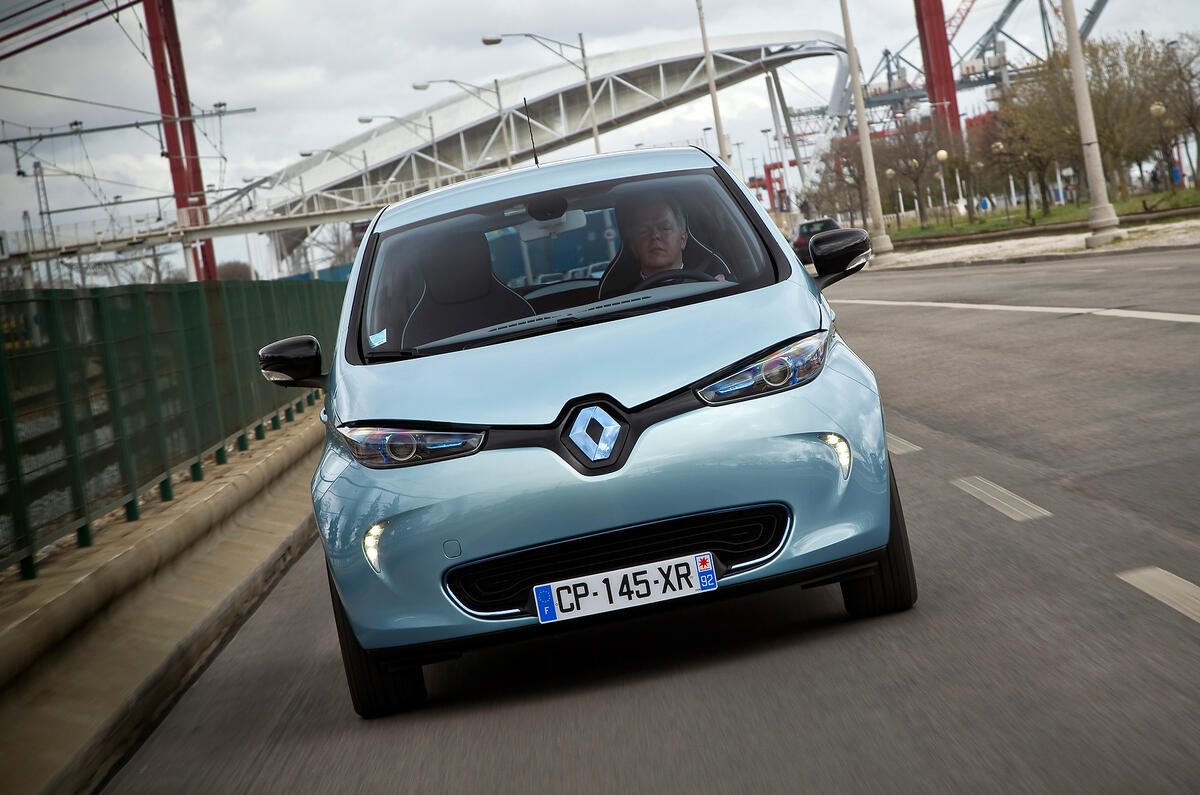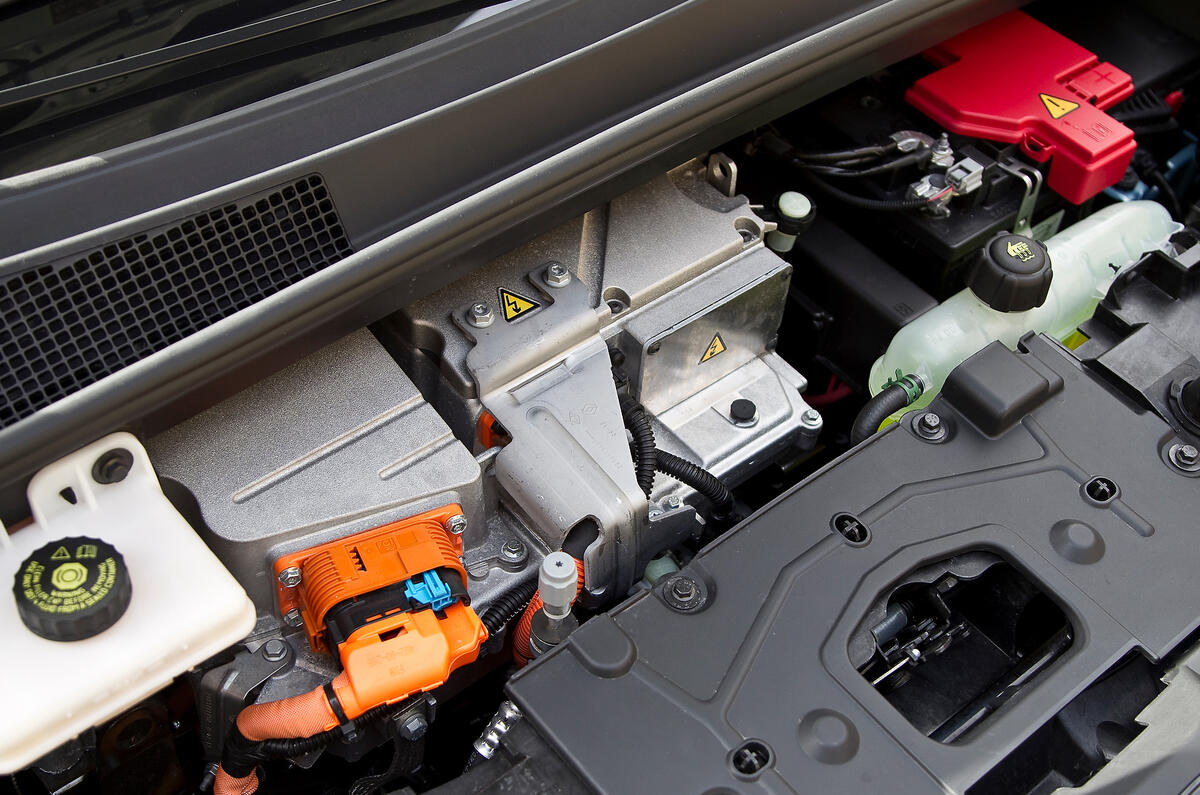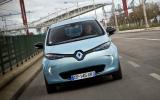What is it?
The Renault Zoe is an all-electric city car, designed for everyday use, that can seat five in comfort.
The Zoe looks great, with clean, crisp, concept car lines that are futuristic but not outlandish. It features some subtle blue tinting of lights and badges and a calm, sleekly styled cabin with a large 'R-link' display screen. You can pre-heat or pre-cool the cabin while charging, too.
On that all-important topic, the official EU test regime credits the Zoe with a 130-mile range on a full charge. Renault itself reckons on a worst-case 60 miles in winter, 90 miles in summer.
What's it like?
The Zoe's pile of torque is instantly available at an ankle flex and delivered with one of three selectable, synthesised and curious hums so pedestrians can hear the Zoe coming. (The hum stops above 18mph, or you can kill it completely.)
That initial friskiness on getaway fades significantly as speed rises, and the the upper limit is set at 84mph to conserve the battery and prevent the motor over-revving. But there’s enough urge here for you not to crave more even in Eco mode, which stifles the scorching starts but feels fine on the open road while adding another 10 per cent or so to the range.
The Zoe corners with conviction and stays flat while resisting understeer. You can feel the weight, all 1468kg of it, but the centre of gravity is lower than the latest Renault Clio’s, whose platform the Zoe shares. That’s because the 22kWh, 400V battery pack is spread under the floor, so the Zoe is a proper five-seater with a normal-size boot.
Initially the battery promised 81 miles, but a check after 22 gentle suburban miles showed 70 miles of remaining range. The range was down to 43 miles after a further 14 miles of rapid driving with full acceleration, but after ambling for another 14 miles there was still 42 miles of range left. Overall, the Zoe went further than its range-calculator initially thought it would.
Among its range-extending devices is a reversible air-con system that heats the Renault Zoe as well as cooling it without stealing much energy from the battery.
Energy recuperation from slowing or braking is strong, too, but the integration of virtual brakes with real ones isn’t entirely smooth and feathering to a gentle halt takes some skill. More jolts come when the wheels fall heavily into road surface breaks, but otherwise the ride is smooth and supple on the bespoke Michelin Energy Z-E tyres.
Should I buy one?
This is an electric car that you could actually consider buying, helped by the free fitment of a home charging unit, paid for by Renault (25 per cent) and the government (75 per cent).
In city traffic the Zoe makes even more sense. It waits patiently and silently at the lights, surrounded by clattery, time-served diesels that seem like relics.
When the lights switch to green, the Zoe streaks ahead of dawdling hatchbacks to snick into gaps. It's a brilliant urban car.
John Simister
Renault Zoe Dynamique Intens
Price £15,195, plus battery rental from £70 pm; 0-62mph 13.5sec; Top speed 84mph (limited); Range 130 miles max; CO2 0g/km; Kerb weight 1468kg; Engine Electric motor; Power 87bhp at 3000-11,300rpm; Torque 162lb ft at 250-2500rpm; Gearbox Single-speed, clutchless























Join the debate
Add your comment
Lovely design, flawed EV tech for some
Loving the Zoe's design, both interior and exterior, but it would never work for me due to my living accomodation not being suitable for home charging. The nearest charging point from my workplace is 1.5 miles away, too. Shame because an EV would be a viable option for me - 6 mile commute each way, no longer journeys.
It looks nice,inside and out.
It looks nice, inside and out. More importantly, it looks normal. There are only so many people who want to be seen in a car that is obviously electric, plus it doesn't have the compromise image of a normal car converted to electric power.
The downside is the range and 'refuelling' limitations. Run out of electriciity and you can't get take a can to the nearest filling station.
Journalists' driving impressions are based on a short spell with the car in optimum conditions, probably only driven during the day. What's the range on a wet night with lights and wipers and radio on? A mimum of 60 miles is quoted for Winter which is probably for a new car, but full battery charge reduces over it's life so what is the range for a 2 year old car, and what if you don't have time to get a full charge?
Bear in mind that the range is between charging points so a round trip, such as a journey to work, without a charging opportunity at the other end of the journey gives an effective distance of 30 miles in each direction.
How much will this be reduced by a traffic jam? 5 miles or so of stop - start crawl caused by somebody having an accident in rush hour?
In short, what's it like to use in real life? Will Autocar be able to get one for a long-term test?
Depreciation could be your friend
There's another interesting financial aspect to this car.
It's real price is £20K but the government give you a grant of £5K towards purchase (let's ignore the rights and wrongs of this for the moment and just accept that it is fact).
It's unlikely that this grant is going to last forever, so at some point new prices will rise to £20K and that will increase second hand prices too.
If depreciation is low (or the prices increase) the true cost of ownership of this car could be tiny.
However, you have to bare in mind that it is still a Renault and almost certainly poorly built of the very cheapest plastics. Renaults I have owned have always struggled with poor electrics so I don't think I'd want a car powered by electrics made at one of their factories.